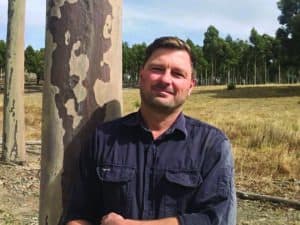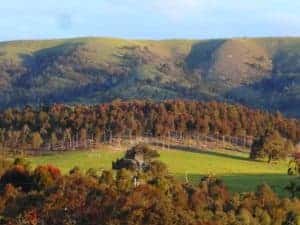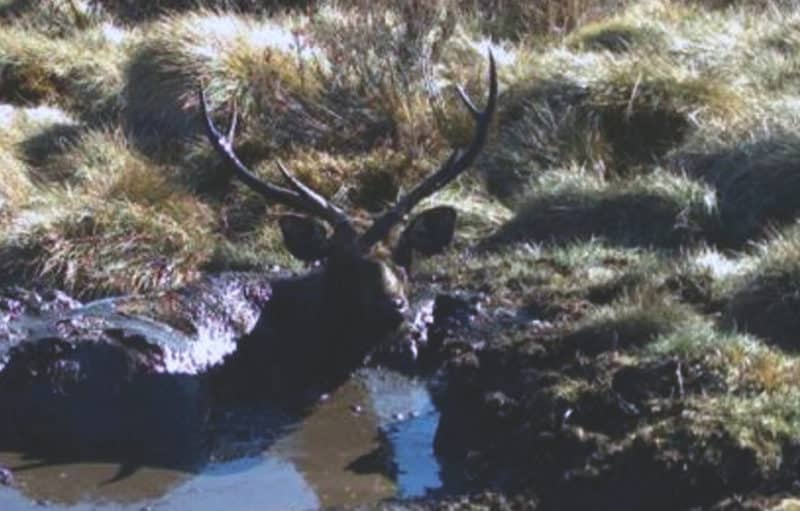PARK WATCH June 2018 |
As winter descends, are you one of many conflicted about sourcing firewood to heat your home? Ben Boxshall, land manager, forestry practitioner and a member of the Victoria-based Australian Agroforestry Foundation, explains the options.

As I place a billet of wood on the fire, watch it ignite and burn hot and clean, and feel the resultant pulse of radiation and warmth, I can’t help but contemplate the wonder of it. I feel a real sense of reward that I am benefiting so directly from a tree I planted as a younger man.
Wood is not only a versatile, renewable and biodegradable material of immense strength, diversity and durability; a billet like this is technically a battery! This tree harnessed energy from the sun to take carbon from the atmosphere to create sugars, carbohydrates and starches to build its tissues and trunk. Photosynthesis is how energy is harnessed by nature, and it is a process that hasn’t been superseded in over 3 billion years of evolution. No mining, fracking or smelting involved. The light and heat the dog and I am enjoying is in fact solar energy that was stored in chemical form and embodied in the wood.
It is this interception and absorption of light by trees that provides a desirable, cooling effect on our suburbs and cities. Trees have a powerful moderating effect on the environment, providing shade and shelter for animals, and protecting us from extreme weather. They can help keep us cool, and they can sure help to keep us warm. This same tree has produced pollen and nectar and fruits and seed from its annual production of flowers and foliage, providing food and shelter for creatures big and small.
And now, less than two years since it was harvested for its wood, the same tree has regrown from the stump. It is already over three cubic metres tall and is again growing wood and storing carbon to complete the cycle. Almost all of our native trees are able to coppice – to regrow again from the stump following harvest. Historical evidence suggests people have been using this ability to regrow trees from the stump for fuel wood for over 5,000 years. This ability to coppice means that a tree plantation can be a permanent system, providing a perpetual source of wood, timber and habitat. Of course this moment of self-satisfaction came only after wielding a chainsaw, working the splitter and leaving it to dry for a year or two. But this is home grown biotechnology. Elon Musk didn’t even have a hand in it. It feels good to take direct responsibility for a significant chunk of our household’s energy consumption.
Should I feel conflicted? If tree planting is a central tenet of the environmental movement, cutting them down must be counterproductive?
The wood and timber that we use can only come from trees that have been cut. But most Victorians don’t know where their firewood comes from.
Few landowners grow trees for the purpose. Many rely on ‘tidying up’ wood that should be left for habitat around remnant paddock trees and bush blocks, or they purchase wood from merchants that haul it in from forests interstate. In fact, most of the forest products Victorians consume are extracted from forests in faraway places.
Victoria has cleared a higher proportion of its native vegetation than any other state. Whether you care about soil health, water quality, tree cover or biodiversity, ‘decline’ is the key word used to describe the current state of our environment. Despite three decades of Landcare, we haven’t planted enough trees to adequately protect our soils, waterways and farms, let alone the native plants and animals that rely on them. We’re certainly not planting enough trees in Victoria to create the ‘climate ready economy’ our government says it wants.
Trees help to stabilise and protect the land they’re planted on, and improve animal welfare and productivity. Broadening the suite of services we expect from the trees we plant to include the production of forest products like wood and timber could help motivate landowners to invest in trees to diversify their land use, and reverse the pervasive degradation and decline in Victoria’s agricultural landscapes. If more Victorians planted trees on their land, and managed them for wood and timber, everyone would benefit. Planting a tree for wood production is planting a tree for the environment.
The demand for sustainable sources of wood and timber will surely grow, not diminish, as we strive to formulate economic systems that meet our personal and material expectations while also stabilising our planet’s biosphere.
Accelerated action on climate change, along with new manufacturing technologies, could drive a forestry renaissance here, just as it has started to do in parts of Europe, and New Zealand.
Multi-purpose tree plantations on farms can be managed to be many times more productive than native forests and woodlands. It takes foresight, and investment, but we could choose to take responsibility for not only our firewood consumption, but create alternative sources of all forest products.

Where is your firewood coming from?
Conservative estimates put the amount of firewood consumed by Victorians at more than half a million tonnes a year.
The removal of a permit system for domestic firewood collection in Victoria’s state forests in 2015 – previously in place since 1958 – has also increased pressure on traditional firewood sources.
There is no genuine environmental accreditation for firewood sourced from these forests, so the wood you burn may be contributing to the loss of habitat for our threatened wildlife.
If left on the ground in a forest, fallen branches form valuable shelter for native species. Taking firewood from native forests particularly threatens reptiles, birds and mammals. It can impact upon threatened species such as the squirrel glider, carpet python and brush-tailed phascogale (also known as tuan). Across Australia 21 species of native birds are considered threatened by firewood collection – 19 of them are found in Victoria.
Permits are no longer required (though you are supposed submit a form online) to collect firewood for domestic use from state forests and those parks where collection is allowed (mostly some parts of red gum parks).
The current system allows domestic firewood collection in designated firewood collection areas during a firewood collection season: autumn (1 March to 30 June) or spring (1 September to 30 November).
Two cubic metres is the maximum volume of firewood (about a ute or small trailed load) which may be collected per person per day in a designated domestic firewood collection area. See: www.ffm.vic.gov.au/ firewood/firewood-collection-inyour-region
For non-compliance there is capacity for on-the-spot fines of around $600 and offences that go to court may be liable for fines of up to $7,926, one year imprisonment, or both. But it is unclear if there is much enforcement.
It would be much better to be able to source firewood from small scale wood lots on private land, grown and managed specifically for that purpose. This has many benefits, which can be part of a broader landscape restoration strategy (used in conjunction with permanent revegetation), or part of an diversified income stream for farmers.
The key problem is that there is a not a level playing field. The state government essentially gives firewood away for free for domestic users, and for very low fees for commercial native forest harvesting. A private provider will find it hard to compete on price, and there are few incentives for rural landholders to invest in woodlots. Our state government needs to step in with sensible policy settings, which reduce reliance on native forest extraction and incentivise woodlots for firewood and other uses.
Did you like reading this article? Want to be kept up to date about nature issues in Victoria? Subscribe to our email updates.
You can also receive our print magazine Park Watch four times a year by becoming a member. Find out more here.
